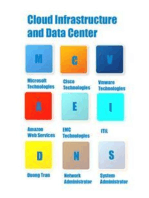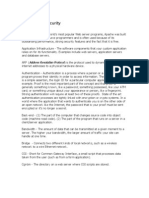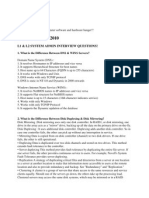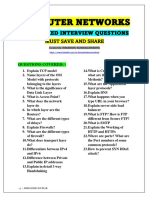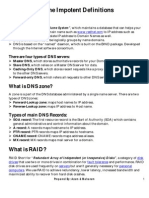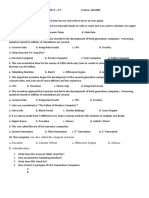Computer Networks Interview Questions
Uploaded by
api-3768969Computer Networks Interview Questions
Uploaded by
api-3768969Computer Networks Interview Questions
Computer Networks Interview
Questions
(Check out your FREE Bonuses at the end of this eBook)
© JobsAssist.com (www.jobsassist.com ) and VyomWorld.com (www.vyomworld.com ) – Free Student Resources
Computer Networks Interview Questions
1. What are 10Base2, 10Base5 and 10BaseT Ethernet LANs
10Base2—An Ethernet term meaning a maximum transfer rate of 10 Megabits per second that uses baseband
signaling, with a contiguous cable segment length of 100
meters and a maximum of 2 segments.
10Base5—An Ethernet term meaning a maximum transfer rate of 10 Megabits per second that uses baseband
signaling, with 5 continuous segments not exceeding 100
meters per segment.
10BaseT—An Ethernet term meaning a maximum transfer rate of 10 Megabits per second that uses baseband
signaling and twisted pair cabling.
2. What is the difference between an unspecified passive open and a fully specified passive open
An unspecified passive open has the server waiting for a connection request from a client. A fully specified passive
open has the server waiting for a connection from a
specific client.
3. Explain the function of Transmission Control Block
A TCB is a complex data structure that contains a considerable amount of information about each connection.
4. What is a Management Information Base (MIB)
A Management Information Base is part of every SNMP-managed device. Each SNMP agent has the MIB database that
contains information about the device's status, its
performance, connections, and configuration. The MIB is queried by SNMP.
5. What is anonymous FTP and why would you use it
Anonymous FTP enables users to connect to a host without using a valid login and password. Usually, anonymous FTP
uses a login called anonymous or guest, with the
password usually requesting the user's ID for tracking purposes only. Anonymous FTP is used to enable a large number
of users to access files on the host without having
to go to the trouble of setting up logins for them all. Anonymous FTP systems usually have strict controls over the areas
an anonymous user can access.
6. What is a pseudo tty
A pseudo tty or false terminal enables external machines to connect through Telnet or rlogin. Without a pseudo tty, no
connection can take place.
7. What is REX
What advantage does REX offer other similar utilities
8. What does the Mount protocol do
The Mount protocol returns a file handle and the name of the file system in which a requested file resides. The message
is sent to the client from the server after reception
of a client's request.
9. What is External Data Representation
© JobsAssist.com (www.jobsassist.com ) and VyomWorld.com (www.vyomworld.com ) – Free Student Resources
Computer Networks Interview Questions
External Data Representation is a method of encoding data within an RPC message, used to ensure that the data is not
system-dependent.
10. What is the Network Time Protocol ?
11. BOOTP helps a diskless workstation boot. How does it get a message to the network looking for its IP
address and the location of its operating system boot files
BOOTP sends a UDP message with a subnetwork broadcast address and waits for a reply from a server that gives it
the IP address. The same message might contain the
name of the machine that has the boot files on it. If the boot image location is not specified, the workstation sends
another UDP message to query the server.
12. What is a DNS resource record
A resource record is an entry in a name server's database. There are several types of resource records used, including
name-to-address resolution information. Resource
records are maintained as ASCII files.
13. What protocol is used by DNS name servers
DNS uses UDP for communication between servers. It is a better choice than TCP because of the improved speed a
connectionless protocol offers. Of course,
transmission reliability suffers with UDP.
14. What is the difference between interior and exterior neighbor gateways
Interior gateways connect LANs of one organization, whereas exterior gateways connect the organization to the outside
world.
15. What is the HELLO protocol used for
The HELLO protocol uses time instead of distance to determine optimal routing. It is an alternative to the Routing
Information Protocol.
16. What are the advantages and disadvantages of the three types of routing tables
The three types of routing tables are fixed, dynamic, and fixed central. The fixed table must be manually modified every
time there is a change. A dynamic table changes its
information based on network traffic, reducing the amount of manual maintenance. A fixed central table lets a manager
modify only one table, which is then read by other
devices. The fixed central table reduces the need to update each machine's table, as with the fixed table. Usually a
dynamic table causes the fewest problems for a network
administrator, although the table's contents can change without the administrator being aware of the change.
17. What is a TCP connection table
18. What is source route
It is a sequence of IP addresses identifying the route a datagram must follow. A source route may
optionally be included in an IP datagram header.
© JobsAssist.com (www.jobsassist.com ) and VyomWorld.com (www.vyomworld.com ) – Free Student Resources
Computer Networks Interview Questions
19. What is RIP (Routing Information Protocol)
It is a simple protocol used to exchange information between the routers.
20. What is SLIP (Serial Line Interface Protocol)
It is a very simple protocol used for transmission of IP datagrams across a serial line.
21. What is Proxy ARP
It is using a router to answer ARP requests. This will be done when the originating host believes that a destination is
local, when in fact is lies beyond router.
22. What is OSPF
It is an Internet routing protocol that scales well, can route traffic along multiple paths, and uses knowledge of an
Internet's topology to make accurate routing decisions.
23. What is Kerberos
It is an authentication service developed at the Massachusetts Institute of Technology. Kerberos uses encryption to
prevent intruders from discovering passwords and
gaining unauthorized access to files.
24. What is a Multi-homed Host
It is a host that has a multiple network interfaces and that requires multiple IP addresses is called as a Multi-homed
Host.
25. What is NVT (Network Virtual Terminal)
It is a set of rules defining a very simple virtual terminal interaction. The NVT is used in the start of a Telnet session.
26. What is Gateway-to-Gateway protocol
It is a protocol formerly used to exchange routing information between Internet core routers.
27. What is BGP (Border Gateway Protocol)
It is a protocol used to advertise the set of networks that can be reached with in an autonomous system. BGP enables
this information to be shared with the autonomous
system. This is newer than EGP (Exterior Gateway Protocol).
28. What is autonomous system
It is a collection of routers under the control of a single administrative authority and that uses a common Interior
Gateway Protocol.
29. What is EGP (Exterior Gateway Protocol)
It is the protocol the routers in neighboring autonomous systems use to identify the set of networks that can be reached
within or via each autonomous system.
© JobsAssist.com (www.jobsassist.com ) and VyomWorld.com (www.vyomworld.com ) – Free Student Resources
Computer Networks Interview Questions
30. What is IGP (Interior Gateway Protocol)
It is any routing protocol used within an autonomous system.
31. What is Mail Gateway
It is a system that performs a protocol translation between different electronic mail delivery protocols.
32. What is wide-mouth frog
Wide-mouth frog is the simplest known key distribution center (KDC) authentication protocol.
33. What are Digrams and Trigrams
The most common two letter combinations are called as digrams. e.g. th, in, er, re and an. The most common three
letter combinations are called as trigrams. e.g. the, ing,
and, and ion.
34. What is silly window syndrome
It is a problem that can ruin TCP performance. This problem occurs when data are passed to the sending TCP entity in
large blocks, but an interactive application on the
receiving side reads 1 byte at a time.
35. What is region
When hierarchical routing is used, the routers are divided into what we call regions, with each router knowing all the
details about how to route packets to destinations
within its own region, but knowing nothing about the internal structure of other regions.
36. What is multicast routing
Sending a message to a group is called multicasting, and its routing algorithm is called multicast routing.
37. What is traffic shaping
One of the main causes of congestion is that traffic is often busy. If hosts could be made to transmit at a uniform rate,
congestion would be less common. Another open loop
method to help manage congestion is forcing the packet to be transmitted at a more predictable rate. This is called
traffic shaping.
38. What is packet filter
Packet filter is a standard router equipped with some extra functionality. The extra functionality allows every incoming or
outgoing packet to be inspected. Packets meeting
some criterion are forwarded normally. Those that fail the test are dropped.
39. What is virtual path
Along any transmission path from a given source to a given destination, a group of virtual circuits can be grouped
together into what is called path.
© JobsAssist.com (www.jobsassist.com ) and VyomWorld.com (www.vyomworld.com ) – Free Student Resources
Computer Networks Interview Questions
40. What is virtual channel
Virtual channel is normally a connection from one source to one destination, although multicast connections are also
permitted. The other name for virtual channel is virtual
circuit.
41. What is logical link control
One of two sublayers of the data link layer of OSI reference model, as defined by the IEEE 802 standard. This sublayer
is responsible for maintaining the link between
computers when they are sending data across the physical network connection.
42. Why should you care about the OSI Reference Model
It provides a framework for discussing network operations and design.
43. What is the difference between routable and non- routable protocols
Routable protocols can work with a router and can be used to build large networks. Non-Routable protocols are
designed to work on small, local networks and cannot be
used with a router
44. What is MAU
In token Ring , hub is called Multistation Access Unit(MAU).
45. Explain 5-4-3 rule
In a Ethernet network, between any two points on the network, there can be no more than five network segments or four
repeaters, and of those five segments only three of
segments can be populated.
46. What is the difference between TFTP and FTP application layer protocols
The Trivial File Transfer Protocol (TFTP) allows a local host to obtain files from a remote host but does not provide
reliability or security. It uses the fundamental packet
delivery services offered by UDP.
The File Transfer Protocol (FTP) is the standard mechanism provided by TCP / IP for copying a file from one host to
another. It uses the services offered by TCP and so is
reliable and secure. It establishes two connections (virtual circuits) between the hosts, one for data transfer and another
for control information.
47. What is the range of addresses in the classes of internet addresses
Class A 0.0.0.0 - 127.255.255.255
Class B 128.0.0.0 - 191.255.255.255
Class C 192.0.0.0 - 223.255.255.255
Class D 224.0.0.0 - 239.255.255.255
Class E 240.0.0.0 - 247.255.255.255
48. What is the minimum and maximum length of the header in the TCP segment and IP datagram
The header should have a minimum length of 20 bytes and can have a maximum length of 60 bytes.
© JobsAssist.com (www.jobsassist.com ) and VyomWorld.com (www.vyomworld.com ) – Free Student Resources
Computer Networks Interview Questions
49. What is difference between ARP and RARP
The address resolution protocol (ARP) is used to associate the 32 bit IP address with the 48 bit physical address, used
by a host or a router to find the physical address of
another host on its network by sending a ARP query packet that includes the IP address of the receiver.
The reverse address resolution protocol (RARP) allows a host to discover its Internet address when it knows only its
physical address.
50. What is ICMP
ICMP is Internet Control Message Protocol, a network layer protocol of the TCP/IP suite used by hosts and gateways to
send notification of datagram problems back to the
sender. It uses the echo test / reply to test whether a destination is reachable and responding. It also handles both
control and error messages.
51. What are the data units at different layers of the TCP / IP protocol suite
The data unit created at the application layer is called a message, at the transport layer the data unit created is called
either a segment or an user datagram, at the network
layer the data unit created is called the datagram, at the data link layer the datagram is encapsulated in to a frame and
finally transmitted as signals along the transmission
media.
52. What is Project 802
It is a project started by IEEE to set standards that enable intercommunication between equipment from a variety of
manufacturers. It is a way for specifying functions of the
physical layer, the data link layer and to some extent the network layer to allow for interconnectivity of major LAN
protocols.
It consists of the following:
802.1 is an internetworking standard for compatibility of different LANs and MANs across protocols.
802.2 Logical link control (LLC) is the upper sublayer of the data link layer which is non-architecture-specific, that is
remains the same for all IEEE-defined LANs.
Media access control (MAC) is the lower sublayer of the data link layer that contains some distinct modules each
carrying proprietary information specific to the LAN product
being used. The modules are Ethernet LAN (802.3), Token ring LAN (802.4), Token bus LAN (802.5).
802.6 is distributed queue dual bus (DQDB) designed to be used in MANs.
53. What is Bandwidth
Every line has an upper limit and a lower limit on the frequency of signals it can carry. This limited range is called the
bandwidth.
54. Difference between bit rate and baud rate.
Bit rate is the number of bits transmitted during one second whereas baud rate refers to the number of signal units per
second that are required to represent
those bits.
baud rate = bit rate / N
where N is no-of-bits represented by each signal shift.
55. What is MAC address
© JobsAssist.com (www.jobsassist.com ) and VyomWorld.com (www.vyomworld.com ) – Free Student Resources
Computer Networks Interview Questions
The address for a device as it is identified at the Media Access Control (MAC) layer in the network architecture. MAC
address is usually stored in ROM on the network
adapter card and is unique.
56. What is attenuation
The degeneration of a signal over distance on a network cable is called attenuation.
57. What is cladding
A layer of a glass surrounding the center fiber of glass inside a fiber-optic cable.
58. What is RAID
A method for providing fault tolerance by using multiple hard disk drives.
59. What is NETBIOS and NETBEUI
NETBIOS is a programming interface that allows I/O requests to be sent to and received from a remote computer and it
hides the networking hardware from applications.
NETBEUI is NetBIOS extended user interface. A transport protocol designed by microsoft and IBM for the use on small
subnets.
60. What is redirector
Redirector is software that intercepts file or prints I/O requests and translates them into network requests. This comes
under presentation layer.
61. What is Beaconing
The process that allows a network to self-repair networks problems. The stations on the network notify the other
stations on the ring when they are not receiving the
transmissions. Beaconing is used in Token ring and FDDI networks.
62. What is terminal emulation, in which layer it comes
Telnet is also called as terminal emulation. It belongs to application layer.
63. What is frame relay, in which layer it comes
Frame relay is a packet switching technology. It will operate in the data link layer.
64. What do you meant by "triple X" in Networks
The function of PAD (Packet Assembler Disassembler) is described in a document known as X.3. The standard protocol
has been defined between the terminal and the
PAD, called X.28; another standard protocol exists between hte PAD and the network, called X.29. Together, these
three recommendations are often called "triple X"
65. What is SAP
Series of interface points that allow other computers to communicate with the other layers of network protocol stack.
© JobsAssist.com (www.jobsassist.com ) and VyomWorld.com (www.vyomworld.com ) – Free Student Resources
Computer Networks Interview Questions
66. What is subnet
A generic term for section of a large networks usually separated by a bridge or router.
67. What is Brouter
Hybrid devices that combine the features of both bridges and routers.
68. How Gateway is different from Routers
A gateway operates at the upper levels of the OSI model and translates information between two completely different
network architectures or data formats.
69. What are the different type of networking / internetworking devices
Repeater:
Also called a regenerator, it is an electronic device that operates only at physical layer. It receives the signal in the
network before it becomes weak, regenerates the original
bit pattern and puts the refreshed copy back in to the link.
Bridges:
These operate both in the physical and data link layers of LANs of same type. They divide a larger network in to smaller
segments. They contain logic that allow them to
keep the traffic for each segment separate and thus are repeaters that relay a frame only the side of the segment
containing the intended recipent and control congestion.
Routers:
They relay packets among multiple interconnected networks (i.e. LANs of different type). They operate in the physical,
data link and network layers. They contain software
that enable them to determine which of the several possible paths is the best for a particular transmission.
Gateways:
They relay packets among networks that have different protocols (e.g. between a LAN and a WAN). They accept a
packet formatted for one protocol and convert it to a
packet formatted for another protocol before forwarding it. They operate in all seven layers of the OSI model.
70. What is mesh network
A network in which there are multiple network links between computers to provide multiple paths for data to travel.
71. What is passive topology
When the computers on the network simply listen and receive the signal, they are referred to as passive because they
don’t amplify the signal in any way. Example for
passive topology - linear bus.
72. What are the important topologies for networks
BUS topology:
In this each computer is directly connected to primary network cable in a single line.
Advantages:
Inexpensive, easy to install, simple to understand, easy to extend.
STAR topology:
In this all computers are connected using a central hub.
Advantages:
© JobsAssist.com (www.jobsassist.com ) and VyomWorld.com (www.vyomworld.com ) – Free Student Resources
Computer Networks Interview Questions
Can be inexpensive, easy to install and reconfigure and easy to trouble shoot physical problems.
RING topology:
In this all computers are connected in loop.
Advantages:
All computers have equal access to network media, installation can be simple, and signal does not degrade as much as
in other topologies because each computer
regenerates it.
73. What are major types of networks and explain
Server-based network
Peer-to-peer network
Peer-to-peer network, computers can act as both servers sharing resources and as clients using the resources.
Server-based networks provide centralized control of network resources and rely on server computers to provide
security and network administration
74. What is Protocol Data Unit
The data unit in the LLC level is called the protocol data unit (PDU). The PDU contains of four fields a destination
service access point (DSAP), a source service access
point (SSAP), a control field and an information field. DSAP, SSAP are addresses used by the LLC to identify the
protocol stacks on the receiving and sending machines
that are generating and using the data. The control field specifies whether the PDU frame is a information frame (I -
frame) or a supervisory frame (S - frame) or a
unnumbered frame (U - frame).
75. What is difference between baseband and broadband transmission
In a baseband transmission, the entire bandwidth of the cable is consumed by a single signal. In broadband
transmission, signals are sent on multiple frequencies, allowing
multiple signals to be sent simultaneously.
76. What are the possible ways of data exchange
(i) Simplex (ii) Half-duplex (iii) Full-duplex.
77. What are the types of Transmission media
Signals are usually transmitted over some transmission media that are broadly classified in to two categories.
Guided Media:
These are those that provide a conduit from one device to another that include twisted-pair, coaxial cable and fiber-optic
cable. A signal traveling along any of these media
is directed and is contained by the physical limits of the medium. Twisted-pair and coaxial cable use metallic that accept
and transport signals in the form of electrical
current. Optical fiber is a glass or plastic cable that accepts and transports signals in the form of light.
Unguided Media:
This is the wireless media that transport electromagnetic waves without using a physical conductor. Signals are
broadcast either through air. This is done through radio
communication, satellite communication and cellular telephony.
78. What is point-to-point protocol
© JobsAssist.com (www.jobsassist.com ) and VyomWorld.com (www.vyomworld.com ) – Free Student Resources
Computer Networks Interview Questions
A communications protocol used to connect computers to remote networking services including Internet service
providers.
79. What are the two types of transmission technology available
(i) Broadcast and (ii) point-to-point
80. Difference between the communication and transmission.
Transmission is a physical movement of information and concern issues like bit polarity, synchronization, clock etc.
Communication means the meaning full exchange of information between two communication media.
© JobsAssist.com (www.jobsassist.com ) and VyomWorld.com (www.vyomworld.com ) – Free Student Resources
Computer Networks Interview Questions
FREE Bonus #1 – 500+ Technical Interview Questions with Answers
There are 175 Pages in this eBook which contains the questions on the following streams
with answers
• Data Structures
• C
• C++/OOPS
• Quantitative Aptitude
• UNIX
• RDBMS
• SQL
• Computer Networks
• Operating Systems.
Download URL : www.bestebooksworld.com/digital/
Username : techebook
Password : t@ch@b00k
This is a limited time access to download the eBook, so make sure you
download the eBook before the password gets expired.
Hope you enjoy reading this eBook and it helps you in getting a much
better job!
FREE Bonus #2 – 50 HR Interview Questions with Answers
Download URL : www.bestebooksworld.com/digital/
Username : interview
Password : vyom
© JobsAssist.com (www.jobsassist.com ) and VyomWorld.com (www.vyomworld.com ) – Free Student Resources
You might also like
- 250 Networking Interview Questions and Answers - Sachin P100% (2)250 Networking Interview Questions and Answers - Sachin P70 pages
- 09931201B PinAAcle 900 Series NON-IVD Customer HW Guide PDF100% (1)09931201B PinAAcle 900 Series NON-IVD Customer HW Guide PDF449 pages
- Network Engineer Interview Questions and AnswersNo ratings yetNetwork Engineer Interview Questions and Answers11 pages
- Top Interview Questions For "Network Engineer" Position. Md. Wasif Bin HafizNo ratings yetTop Interview Questions For "Network Engineer" Position. Md. Wasif Bin Hafiz7 pages
- Name Three Steps Which You Would Use To Troubleshoot FTP Server Related ProblemsNo ratings yetName Three Steps Which You Would Use To Troubleshoot FTP Server Related Problems6 pages
- 100 Networking Interview Questions and AnswersNo ratings yet100 Networking Interview Questions and Answers8 pages
- MCSE Questions and Answers:: 1:: What Is The Use of IGMP Protocol?No ratings yetMCSE Questions and Answers:: 1:: What Is The Use of IGMP Protocol?14 pages
- WAN TECHNOLOGY FRAME-RELAY: An Expert's Handbook of Navigating Frame Relay NetworksFrom EverandWAN TECHNOLOGY FRAME-RELAY: An Expert's Handbook of Navigating Frame Relay NetworksNo ratings yet
- CISCO PACKET TRACER LABS: Best practice of configuring or troubleshooting NetworkFrom EverandCISCO PACKET TRACER LABS: Best practice of configuring or troubleshooting NetworkNo ratings yet
- Cisco Network Administration Interview Questions: CISCO CCNA Certification ReviewFrom EverandCisco Network Administration Interview Questions: CISCO CCNA Certification Review4.5/5 (6)
- 200 Networking Interview Questions and Answers - Networking Faq PDF67% (3)200 Networking Interview Questions and Answers - Networking Faq PDF15 pages
- 39 Top MICROSOFT Windows Server Administrator Interview Questions and Answers by A Real Interviewer - Knowledgebase - SeiMaximNo ratings yet39 Top MICROSOFT Windows Server Administrator Interview Questions and Answers by A Real Interviewer - Knowledgebase - SeiMaxim5 pages
- Logical Addressing: IPV4 Addressing - Computer NetworksNo ratings yetLogical Addressing: IPV4 Addressing - Computer Networks19 pages
- Top 100 Networking Interview Questions & AnswersNo ratings yetTop 100 Networking Interview Questions & Answers73 pages
- Windows Admin Interview Questions and Answers.0% (1)Windows Admin Interview Questions and Answers.4 pages
- Interview Questions and Answers For Freshers - TCP - IP PDFNo ratings yetInterview Questions and Answers For Freshers - TCP - IP PDF8 pages
- Top 77 Interview Questions For IT Professionals100% (5)Top 77 Interview Questions For IT Professionals11 pages
- Network Troubleshooting Commands For Windows100% (1)Network Troubleshooting Commands For Windows2 pages
- Networking Interview Question and AnswersNo ratings yetNetworking Interview Question and Answers9 pages
- System Admin Interview Q&A - SHAIK BILAL AHMED100% (1)System Admin Interview Q&A - SHAIK BILAL AHMED20 pages
- 133 VPN Interview Questions Answers GuideNo ratings yet133 VPN Interview Questions Answers Guide6 pages
- Most Asked Networking Interview Questions and AnswersNo ratings yetMost Asked Networking Interview Questions and Answers34 pages
- Top Hardware & Networking Interview Questions & Answers0% (2)Top Hardware & Networking Interview Questions & Answers3 pages
- How To Become A Desktop Engineer: Friday, 25 January 2008No ratings yetHow To Become A Desktop Engineer: Friday, 25 January 20083 pages
- Computer Networks - Most Asked Interview QuestionsNo ratings yetComputer Networks - Most Asked Interview Questions29 pages
- Top 20+ Windows Server Interview Questions and Answers 2024No ratings yetTop 20+ Windows Server Interview Questions and Answers 20247 pages
- CCNA Interview Questions and Answers PDF - Networker InterviewNo ratings yetCCNA Interview Questions and Answers PDF - Networker Interview72 pages
- Citrix Interview Questions Answers GuideNo ratings yetCitrix Interview Questions Answers Guide8 pages
- Week10-Lab-build A Network With Switch and Observe MAC Addresses and ARPNo ratings yetWeek10-Lab-build A Network With Switch and Observe MAC Addresses and ARP9 pages
- 300+ TOP DESKTOP ENGINEER Interview Questions and AnswersNo ratings yet300+ TOP DESKTOP ENGINEER Interview Questions and Answers22 pages
- Technical Support Interview Questions 1 1No ratings yetTechnical Support Interview Questions 1 14 pages
- How To Prepare For Network Engineer Interview QuestionsNo ratings yetHow To Prepare For Network Engineer Interview Questions4 pages
- Networking Basic & Ccna Interview Questions and Answers For FreshersNo ratings yetNetworking Basic & Ccna Interview Questions and Answers For Freshers7 pages
- MCSA: Windows 10 Complete Study Guide: Exam 70-698 and Exam 70-697From EverandMCSA: Windows 10 Complete Study Guide: Exam 70-698 and Exam 70-697No ratings yet
- IPv6 Fundamentals: Learn the Basics of How IPv6 Works, IPv6 Addresses and IPv6 Subnetting: Computer Networking, #2From EverandIPv6 Fundamentals: Learn the Basics of How IPv6 Works, IPv6 Addresses and IPv6 Subnetting: Computer Networking, #24.5/5 (2)
- ASUS B450 B550 X570 Motherboards Cheatsheet Nov2020No ratings yetASUS B450 B550 X570 Motherboards Cheatsheet Nov20203 pages
- GE Fanuc Micro PLC User's Guide, GFK-0803BNo ratings yetGE Fanuc Micro PLC User's Guide, GFK-0803B165 pages
- Bit 3233 Audio Video Production: Analog Audio and Digital AudioNo ratings yetBit 3233 Audio Video Production: Analog Audio and Digital Audio19 pages
- A Parallel FDTD Algorithm Using The MPI LNo ratings yetA Parallel FDTD Algorithm Using The MPI L10 pages
- Liebherr Product Advantage Mobile Crane 178 LTM 11200 9 1 PN 178 00 E02 2014No ratings yetLiebherr Product Advantage Mobile Crane 178 LTM 11200 9 1 PN 178 00 E02 201424 pages
- Datasheet - HK S29al016j70tfi020 6599589No ratings yetDatasheet - HK S29al016j70tfi020 659958958 pages
- 250 Networking Interview Questions and Answers - Sachin P250 Networking Interview Questions and Answers - Sachin P
- 09931201B PinAAcle 900 Series NON-IVD Customer HW Guide PDF09931201B PinAAcle 900 Series NON-IVD Customer HW Guide PDF
- Top Interview Questions For "Network Engineer" Position. Md. Wasif Bin HafizTop Interview Questions For "Network Engineer" Position. Md. Wasif Bin Hafiz
- Name Three Steps Which You Would Use To Troubleshoot FTP Server Related ProblemsName Three Steps Which You Would Use To Troubleshoot FTP Server Related Problems
- MCSE Questions and Answers:: 1:: What Is The Use of IGMP Protocol?MCSE Questions and Answers:: 1:: What Is The Use of IGMP Protocol?
- CCNA Interview Questions You'll Most Likely Be AskedFrom EverandCCNA Interview Questions You'll Most Likely Be Asked
- WAN TECHNOLOGY FRAME-RELAY: An Expert's Handbook of Navigating Frame Relay NetworksFrom EverandWAN TECHNOLOGY FRAME-RELAY: An Expert's Handbook of Navigating Frame Relay Networks
- Network with Practical: ALL PACKET TRACER LABSFrom EverandNetwork with Practical: ALL PACKET TRACER LABS
- CISCO PACKET TRACER LABS: Best practice of configuring or troubleshooting NetworkFrom EverandCISCO PACKET TRACER LABS: Best practice of configuring or troubleshooting Network
- Cisco Network Administration Interview Questions: CISCO CCNA Certification ReviewFrom EverandCisco Network Administration Interview Questions: CISCO CCNA Certification Review
- 200 Networking Interview Questions and Answers - Networking Faq PDF200 Networking Interview Questions and Answers - Networking Faq PDF
- 39 Top MICROSOFT Windows Server Administrator Interview Questions and Answers by A Real Interviewer - Knowledgebase - SeiMaxim39 Top MICROSOFT Windows Server Administrator Interview Questions and Answers by A Real Interviewer - Knowledgebase - SeiMaxim
- Logical Addressing: IPV4 Addressing - Computer NetworksLogical Addressing: IPV4 Addressing - Computer Networks
- Interview Questions and Answers For Freshers - TCP - IP PDFInterview Questions and Answers For Freshers - TCP - IP PDF
- Most Asked Networking Interview Questions and AnswersMost Asked Networking Interview Questions and Answers
- Top Hardware & Networking Interview Questions & AnswersTop Hardware & Networking Interview Questions & Answers
- How To Become A Desktop Engineer: Friday, 25 January 2008How To Become A Desktop Engineer: Friday, 25 January 2008
- Computer Networks - Most Asked Interview QuestionsComputer Networks - Most Asked Interview Questions
- Top 20+ Windows Server Interview Questions and Answers 2024Top 20+ Windows Server Interview Questions and Answers 2024
- CCNA Interview Questions and Answers PDF - Networker InterviewCCNA Interview Questions and Answers PDF - Networker Interview
- Week10-Lab-build A Network With Switch and Observe MAC Addresses and ARPWeek10-Lab-build A Network With Switch and Observe MAC Addresses and ARP
- 300+ TOP DESKTOP ENGINEER Interview Questions and Answers300+ TOP DESKTOP ENGINEER Interview Questions and Answers
- How To Prepare For Network Engineer Interview QuestionsHow To Prepare For Network Engineer Interview Questions
- Networking Basic & Ccna Interview Questions and Answers For FreshersNetworking Basic & Ccna Interview Questions and Answers For Freshers
- MCSA: Windows 10 Complete Study Guide: Exam 70-698 and Exam 70-697From EverandMCSA: Windows 10 Complete Study Guide: Exam 70-698 and Exam 70-697
- IPv6 Fundamentals: Learn the Basics of How IPv6 Works, IPv6 Addresses and IPv6 Subnetting: Computer Networking, #2From EverandIPv6 Fundamentals: Learn the Basics of How IPv6 Works, IPv6 Addresses and IPv6 Subnetting: Computer Networking, #2
- ASUS B450 B550 X570 Motherboards Cheatsheet Nov2020ASUS B450 B550 X570 Motherboards Cheatsheet Nov2020
- Bit 3233 Audio Video Production: Analog Audio and Digital AudioBit 3233 Audio Video Production: Analog Audio and Digital Audio
- Liebherr Product Advantage Mobile Crane 178 LTM 11200 9 1 PN 178 00 E02 2014Liebherr Product Advantage Mobile Crane 178 LTM 11200 9 1 PN 178 00 E02 2014


















